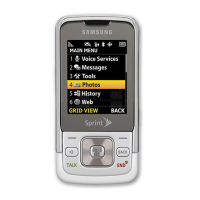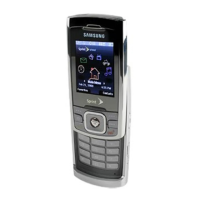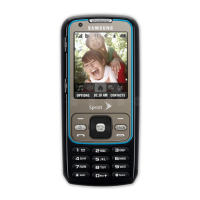Do you have a question about the Samsung SPH-M320 and is the answer not in the manual?
Provides an overview of initial setup steps for your new phone and service.
Details the fundamental functions and features of your new phone.
Explains the calling features that enhance your Sprint service.
Covers important safety guidelines and warranty details for your phone.
An overview of the phone's physical components and their functions.
Explains the phone's display screen and its status indicators.
Highlights key features and service options available on the phone.
Provides instructions on how to power the phone on and off.
Information on battery capacity, charging, and proper usage.
Guide on using the navigation key to scroll through menus quickly.
Instructions on how to view your phone's number and account information.
Covers the process of placing, receiving, and managing phone calls.
Customizing ringer types, tones, and volume for alerts and calls.
Adjusting screen brightness, greetings, and backlight time.
Managing phone location services for privacy and specific applications.
Configuring message notifications, reminders, and auto-deletion.
Enabling or disabling phone features that may interfere with aircraft systems.
Information on using TTY devices for communication with hearing impairments.
Customizing shortcuts, call answer modes, and auto-answer settings.
How to access phone security settings using your lock code.
Guidance on locking your phone for security and managing access.
Explains roaming and how to recognize the roaming icon on the display.
Controls your phone's roaming capabilities by selecting network modes.
Manages roaming calls by requiring an extra step before placing/answering.
Alerts you when roaming off-network and attempting to use data services.
Accessing the list of the last 150 phone numbers for calls placed, accepted, or missed.
Displays call details and options like saving contacts or deleting entries.
Instructions on how to redial numbers directly from the call history.
Steps to save a number from call history into your contacts.
Adds a prefix to a number from call history for out-of-area calls.
Procedures for deleting individual or all call history entries.
Guide to adding new contact information, including names and numbers.
Methods to display contacts by name, speed dial, group, or voice tag.
Editing contact images, names, numbers, email, URLs, nicknames, memos, and ringers.
Instructions for adding an additional phone number to an existing contact.
Modifying an existing phone number for a contact entry.
Steps to delete a contact from your phone's list.
Setting up speed dial numbers for quick access to contacts.
Modifying various fields of an existing contact entry.
Assigning custom ringers to identify specific callers from your contacts.
Accessing Sprint services directly from your contacts list.
Backing up and restoring your contacts to the Sprint Web site.
Organizing your time by adding and managing events in the scheduler.
Setting and managing multiple alarms with various capabilities.
Composing, storing, and retrieving notes and reminders.
Accessing and using the phone's built-in calculator functionality.
Managing daily tasks with dates, times, and priority levels.
Setting a timer that counts down to a specific event date and time.
Viewing the time in over 24 different locations worldwide.
Downloading and installing software updates for your phone.
Downloading and updating the Preferred Roaming List automatically.
Using voice dial tags to automatically dial numbers in your Contacts.
Sending voice messages to recipients via SMS.
Displaying contact information by saying the contact's name.
Quickly accessing voicemail messages and settings.
Recording and managing voice memos for reminders and notes.
Instructions on using the phone's built-in camera to capture images.
Configuring camera settings and viewing account information.
Managing pictures in the In Camera and Online Albums folders.
Sharing pictures instantly with family and friends via messaging.
Using the web site to manage, edit, and share uploaded pictures.
Ordering photo prints from third-party vendors.
Enabling or disabling the phone's Bluetooth feature.
Configuring Bluetooth service, visibility, and device name.
Understanding different Bluetooth profiles like HSP, HFP, DUN, and OPP.
Establishing trusted connections with other Bluetooth devices.
Setting up and accessing voicemail messages and personal greetings.
Sending and receiving instant text messages with preset options.
Sending voice messages to recipients via SMS without making a call.
Managing number display for incoming and outgoing calls.
Managing incoming calls while already on a call.
Talking to two people simultaneously on a single call.
Forwarding all incoming calls to another phone number.
Overview of applications available through phone data services.
Basics of data services, user names, and launching connections.
Sending/receiving email, instant messages, and using chat rooms.
Accessing and downloading premium services like games and ringers.
Browsing full-color graphic versions of websites on your phone.
Frequently asked questions about data connection status and usage.
Basic guidelines for operating the phone safely and maintaining service.
Guidelines for emergency calls, driving safety, and avoiding interference.
Information on phone compatibility with hearing aid devices.
Guidelines for battery performance, charging, and disposal.
Understanding phone RF operation, safety, and SAR values.
Space to record phone model, serial number, and regulatory information.
Proprietary notices and patent information related to the user guide.
Details the standard limited warranty for the phone and accessories.
| 2G bands | CDMA 800 / 1900 |
|---|---|
| GPRS | No |
| EDGE | No |
| Status | Discontinued |
| SIM | Mini-SIM |
| Type | TFT, 65K colors |
| Call records | Yes |
| Loudspeaker | Yes |
| 3.5mm jack | No |
| Radio | No |
| Messaging | SMS, EMS, MMS |
| Browser | WAP 2.0/xHTML |
| Games | Yes |
| Java | Yes, MIDP 2.0 |
| Network Technology | CDMA |
| Size | 2.0 inches |
| Resolution | 176 x 220 pixels |
| Phonebook | Yes |
| Camera | 1.3 MP |
| Alert types | Vibration |
| Bluetooth | v2.0, A2DP |
| USB | Yes |
| Battery | Li-Ion 1000 mAh |
| Colors | Black |











